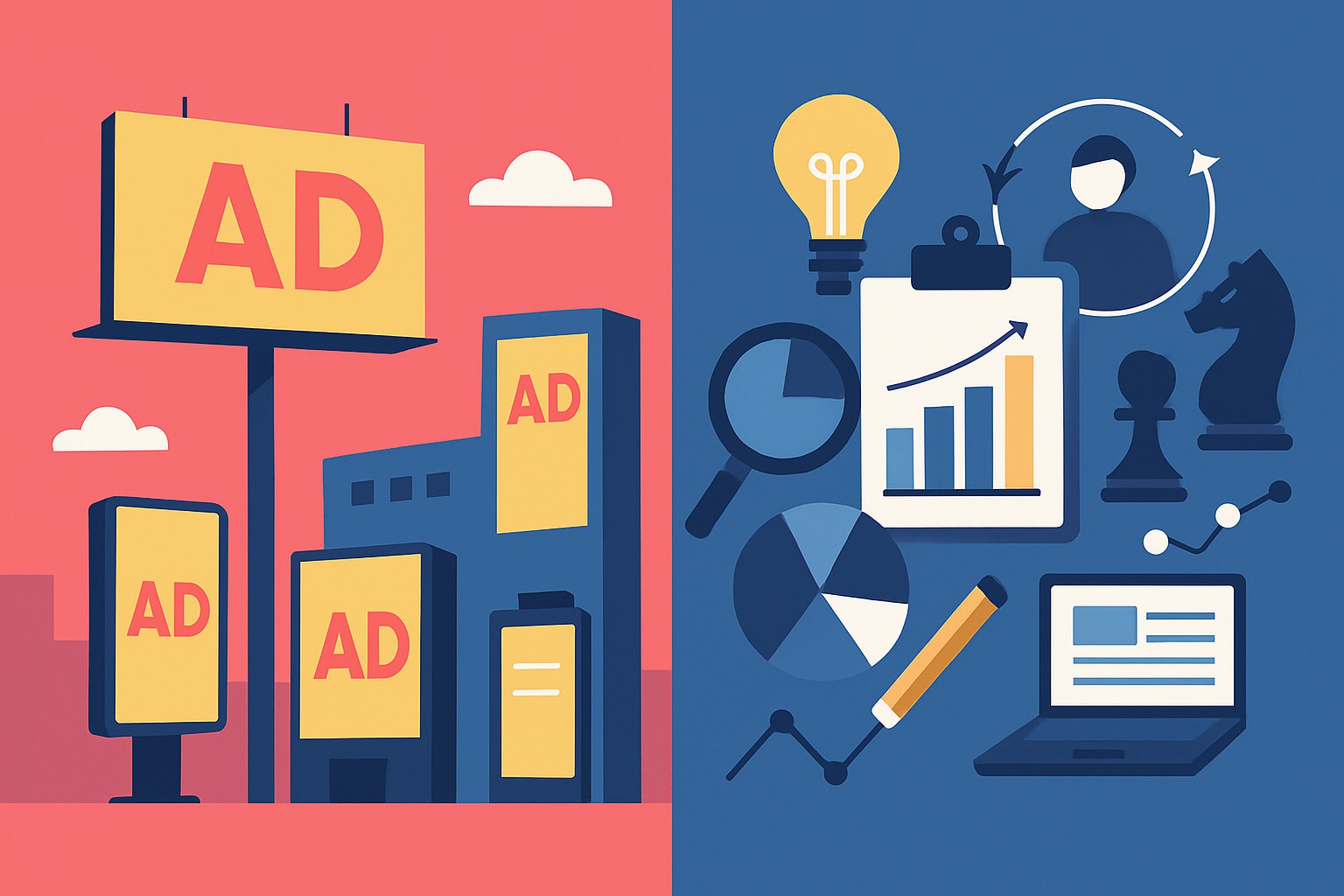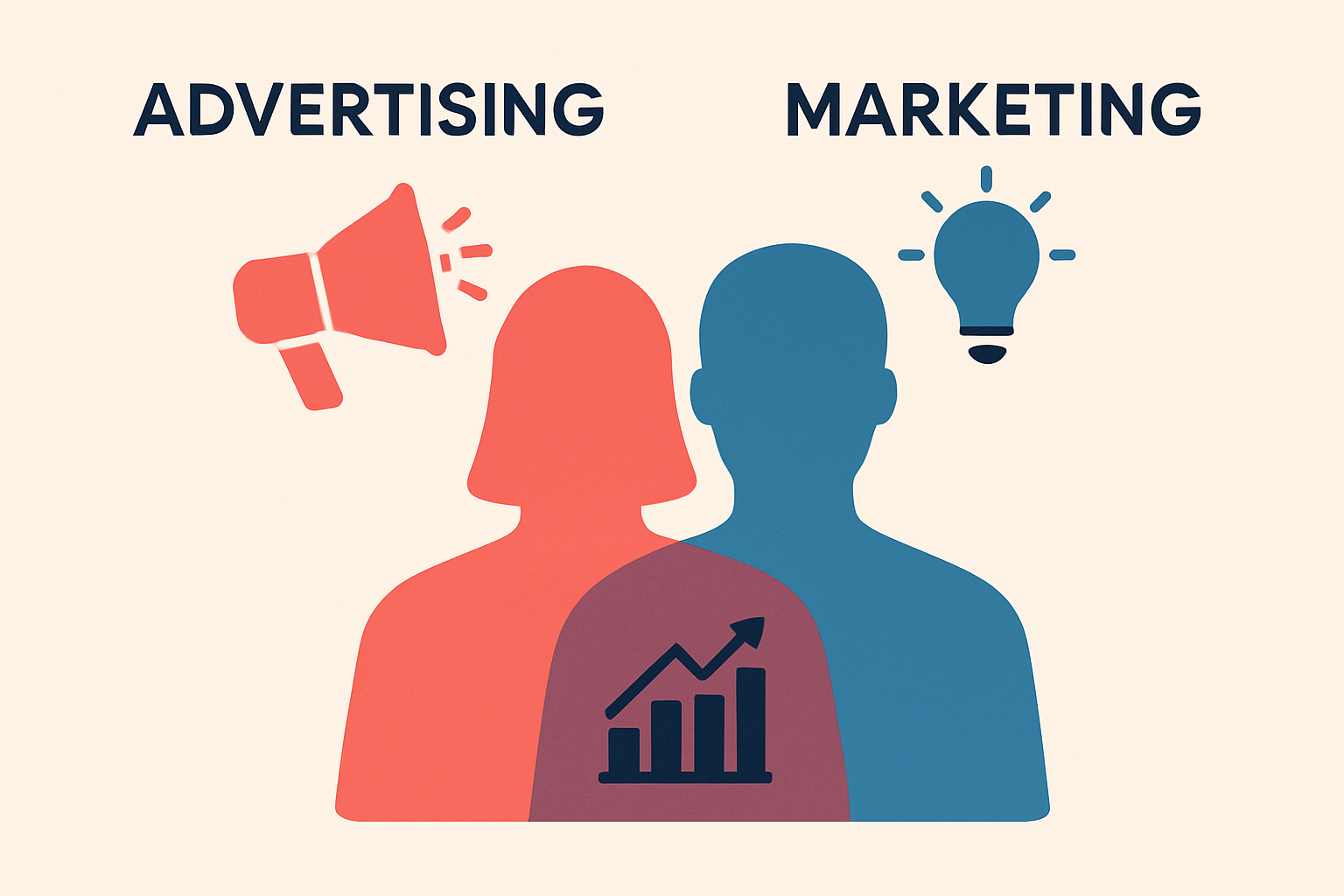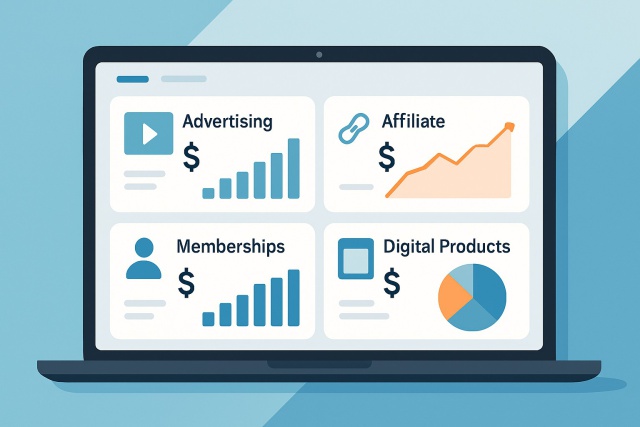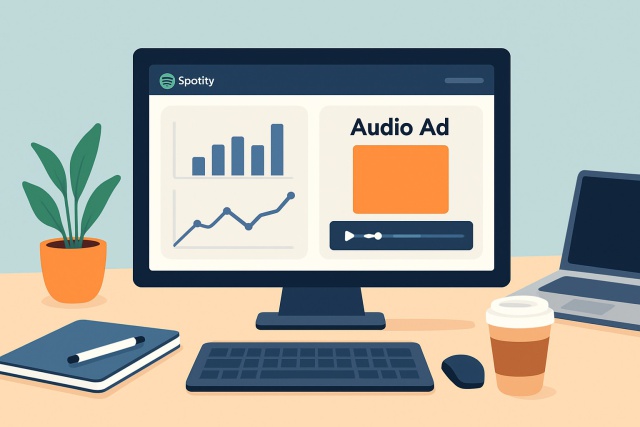Advertising vs Marketing - Key Differences to Understand


It’s really vital to get a handle on the differences between advertising and marketing. People tend to toss these terms around as if they mean the same thing but in reality they each have a unique role in helping businesses grow and connect with their audiences.
Advertising is all about spotlighting products or services through paid channels and aiming to strike a direct conversation with consumers. Marketing casts a wider net by using strategies to get inside the customer's head, boost brand recognition and fuel business growth.
Advertising and Marketing Explained with Key Ideas
Advertising is a deliberate and carefully planned effort aimed at delivering a clear message about a product or service through paid media channels. The main goal is to catch the eye of potential customers and nudge them to take action. Ultimately, it ramps up sales or increases visibility within a specific timeframe. Advertising relies on direct communication and a no-nonsense call-to-action. It focuses on outcomes that can be tracked like impressions and conversions.
Marketing is a broad business discipline that covers everything from market research and product development to pricing strategies and promotion. It also includes distribution. At its heart, it’s about understanding what customers want and prefer and building strong relationships that stand the test of time—going beyond just bombarding people with ads.
| Aspect | Advertising | Marketing |
|---|---|---|
| Definition | Paid promotion of products or services, usually to get the word out fast | A broad approach focused on connecting with markets and customers in meaningful ways |
| Scope | Mainly about delivering a specific message that hits home quickly | Encompasses research, product development, pricing, and distribution—basically the whole shebang |
| Objectives | Aims to give immediate sales or awareness a solid kick-start | Concentrates on building lasting brand value and nurturing customer relationships over time |
| Timing | Typically short-term bursts or campaigns designed to make an impact | Continuous strategies and ongoing efforts that keep the wheels turning |
| Communication Style | One-way, persuasive communication—think of it as a shout from the rooftops | Interactive engagement that invites conversation and creates genuine value |
| Measurability | Clear-cut metrics like CTR and impressions that you can actually count | More subtle, indirect measures like brand strength and loyalty, which grow quietly but surely |
Round 1 Objectives and Aims Setting the Stage for What’s Next
Advertising and marketing might dance to the same tune now and then, but they each have their own moves. Advertising is all about catching your eye and nudging you toward a quick decision, whereas marketing takes the long view—keeping a finger on the pulse of market trends and nurturing those customer relationships that last for the long haul.
- Advertising is all about grabbing attention fast and making sure your product gets noticed in the blink of an eye.
- It’s laser-focused on giving a swift boost to short-term sales and launching new products into the spotlight.
- Advertising tends to nudge people into quick actions like clicking a link or dropping by the store with no dilly-dallying.
- Marketing rolls up its sleeves with deep market research to craft products and customize messages that hit home.
- It’s all about nurturing long-term relationships and turning customers into loyal fans who stick around.
- Marketing plays the long game and drives steady business growth that goes beyond pushing a quick sale.
Round 2 Dialing In on Focus and Tasks
Advertising is a slice of the marketing pie that zooms in on specific promotional efforts while marketing covers everything from strategic planning to helping after the sale is made.
- Advertising is all about crafting eye-catching campaigns and securing prime media spots.
- It covers creating ads for TV, social media, print and online channels to catch your attention.
- Marketing digs deeper with market research and competitor analysis to find hidden opportunities.
- It also involves shaping product development and setting pricing strategies that make sense.
- Plus, marketing manages distribution and plans the best ways to get products into customers' hands.
- While advertising plays a supporting role in marketing it’s just one piece of a bigger puzzle.
Round 3 Channels and Methods Let’s Dive In
Advertising usually leans heavily on paid channels to get its messages across. Marketing takes a more well-rounded approach by blending earned, owned and paid channels to reach audiences in a way that feels more natural and far-reaching.
| Advertising Channels | Marketing Channels |
|---|---|
| TV commercials | Public relations |
| Radio ads | Content marketing (think blogs, podcasts, videos that actually hold your attention) |
| Print advertisements | Search engine optimization (SEO) |
| Paid digital ads (Google Ads, social media ads that pop up just when you’re about to make a decision) | Events and experiential marketing (you know, the kind you remember) |
| Outdoor billboards | Social media (organic posts, community engagement that feels genuine) |
Round 4 Tracking Success and Understanding Your Return on Investment
Advertising success often gets judged by quick tangible wins like impressions and conversions. These are results you can point to right away. Meanwhile, marketing ROI measures slower-building long-lasting factors like brand strength and customer value that really stick around.
- Advertising KPIs usually cover click-through rates, cost-per-click and conversion rates—the bread and butter metrics we lean on.
- Impressions and reach give you a good sense of how visible and impactful an ad really is. It is like the first impression at a party that sets the vibe.
- Marketing often zeroes in on customer lifetime value and brand equity—key players that tell the story behind the scenes.
- Market share and customer retention rates are the trusty gauges that help us figure out if marketing efforts are hitting the mark or just spinning wheels.
- Marketing ROI usually takes the long view measured over a stretch of time longer than what we would typically see with advertising ROI.
Round 5 Taking a Closer Look at Budget and Costs Because Every Penny Counts
Advertising budgets usually depend on the campaign's goals and duration as well as the often unpredictable media costs. You might end up with a hefty upfront bill for a shorter campaign that packs a punch. Typical expenses include buying airtime for TV ads, running digital pay-per-click campaigns and creating the content itself. These costs don’t just appear out of thin air. They require careful justification based on the expected return on investment for each campaign. Meanwhile, marketing budgets tend to be more varied and cover research, product development, customer service and ongoing efforts to keep the brand fresh and relevant.
A key difference lies in how flexible advertising spend can be. Companies often tweak their ad budgets on the fly depending on campaign schedules or seasonal events like big retail sales. Marketing investments are usually more set in stone. Think ongoing strategies like SEO, content marketing and customer loyalty programs that keep chugging along. Take tools like Moz or Mangools for instance. They are the secret sauce businesses use to fine-tune their SEO efforts as part of a broader marketing game plan.
Round 6 Timing and How Long the Campaign Runs The Clock’s Ticking
Advertising campaigns usually stick to set schedules, with clear start and end dates crafted to pack a timely punch. Marketing initiatives tend to unfold over longer periods, flexing and adapting as market trends and customer vibes shift along the way.
A company might launch a fast-paced 4-week advertising blitz to unveil a new product. Behind the scenes the marketing team carefully tweaks messaging, distribution strategies and customer engagement over months or even years
Round 7 Getting to Grips with Roles and Teams
Advertising teams usually bring together specialists who focus on creative production and media planning and manage paid channels. Marketing teams often handle a broader array of roles, covering research, strategy, product management, and digital engagement.
- Advertising jobs typically bring together a colorful cast of characters like creative directors, copywriters, art directors and media planners each adding their unique flair.
- Account managers juggle client campaigns and keep those budgets in check making sure everything runs smoothly.
- Marketing teams are a mixed bag too featuring market researchers, product managers, brand strategists and digital marketers all working behind the scenes to craft strategies that stick.
- Data analysts lend a hand by digging into customer insights and turning raw data into growth opportunities. They are really the unsung heroes.
- SEO specialists often lean on trusty tools like Moz Pro or Mangools to give marketing efforts that extra organic reach boost. They quietly work their magic in the background.
- Social media managers are vital connectors supporting both marketing communications and advertising campaigns. They often juggle multiple platforms as if it’s second nature.

Infographic showing overlap and distinctions between advertising and marketing roles
Real-World Use Cases for Choosing Advertising or Marketing
Deciding whether to zero in on advertising or marketing really boils down to your business goals and needs as well as the timing of it all. Advertising usually shines when you are aiming to get your name out there fast and give sales a quick jolt.
- When a product needs to grab market attention fast, a well-targeted advertising campaign usually does the trick.
- Those advertising blitzes can really pack a punch, especially when supporting promotions and seasonal sales.
- Stepping into a new market often requires a well-rounded marketing plan that includes solid research and smart positioning.
- Building a brand mostly involves keeping your marketing messages consistent over the long haul.
- Marketing also includes customer relationship programs designed to boost loyalty because keeping customers around is half the battle.
- And don’t forget ongoing SEO tuning with tools like Moz or Mangools, which quietly work behind the scenes to help organic growth increase steadily.
Which One Really Takes the Cake?
Advertising and marketing both play key roles in business success but tend to shine in different ways. Advertising is your go-to when you need a quick splash that grabs eyeballs fast and drives sales right out of the gate. Meanwhile, marketing is more like the patient gardener who cultivates a brand over time, keeps customers engaged and lays down the groundwork for smart growth. Businesses often hit the jackpot by mixing advertising with a solid marketing plan. Tools like Moz Pro and Mangools lend a hand by boosting SEO and helping you make savvy data-driven calls—showing how far marketing’s influence can stretch.
Unlock Digital Marketing Success with Moz
Struggling to optimize your online presence? Moz is the ultimate Internet Marketing solution, empowering businesses with powerful SEO tools, insightful analytics, and expert guidance. Elevate your digital strategies and outshine the competition.
- Boost organic traffic with data-driven SEO tactics
- Enhance content marketing with expert recommendations
- Gain a competitive edge with comprehensive link analysis








